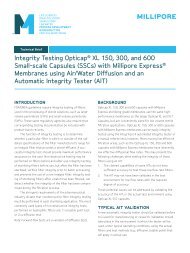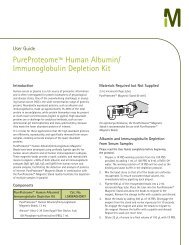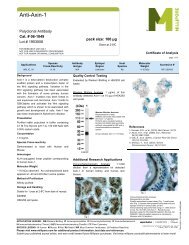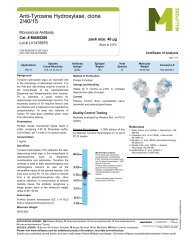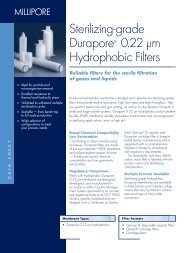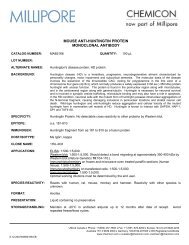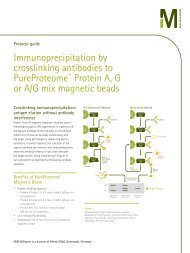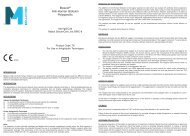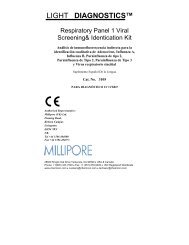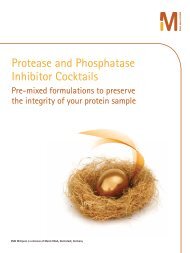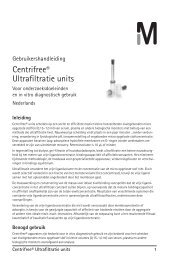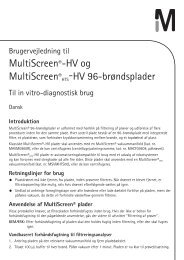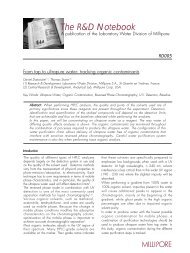User Guide for Reversed-Phase - Millipore
User Guide for Reversed-Phase - Millipore
User Guide for Reversed-Phase - Millipore
Create successful ePaper yourself
Turn your PDF publications into a flip-book with our unique Google optimized e-Paper software.
<strong>User</strong> <strong>Guide</strong><br />
<strong>for</strong> <strong>Reversed</strong>-<strong>Phase</strong><br />
Pipette Tips <strong>for</strong> Sample Preparation
Notice<br />
The in<strong>for</strong>mation in this document is subject to change without notice<br />
and should not be construed as a commitment by <strong>Millipore</strong> Corporation.<br />
<strong>Millipore</strong> Corporation assumes no responsibility <strong>for</strong> any errors<br />
that may appear in this document. This manual is believed to be complete<br />
and accurate at the time of publication. In no event shall <strong>Millipore</strong><br />
Corporation be liable <strong>for</strong> incidental or consequential damages in connection<br />
with or arising from the use of this manual.<br />
PR02358, Rev. A, 02/07<br />
© 2007 <strong>Millipore</strong> Corporation. All rights reserved.<br />
<strong>Millipore</strong> is a registered trademark of <strong>Millipore</strong> Corporation.<br />
ZipTip and Milli-Q are registered trademarks of <strong>Millipore</strong> Corporation.<br />
GELoader is a trademark of Eppendorf-Netheler-Hinz GmbH.<br />
Tween is a registered trademark of ICI Americas Inc.<br />
Triton is a registered trademark of Union Carbide Corporation.<br />
Proline is a trademark of Biohit Oy.
Introduction<br />
The ZipTip ® pipette tip is a 10 µL pipette tip with a<br />
bed of chromatography media fixed at its end. It is<br />
intended <strong>for</strong> concentrating and purifying peptide,<br />
protein or oligonucleotide samples.<br />
These instructions describe the use of ZipTip pipette<br />
tips containing C and C reversed-phase media <strong>for</strong><br />
18 4<br />
desalting and concentrating peptides and proteins.<br />
For in<strong>for</strong>mation on concentrating and desalting<br />
oligonucleotide samples, request <strong>Millipore</strong> publication<br />
TN225.<br />
NOTE: Because the adsorptive bed provides a slight<br />
back pressure, do not use the ZipTip pipette<br />
tip <strong>for</strong> accurate volumetric dispensing. To<br />
achieve optimal sample uptake and delivery,<br />
set the pipettor to 10 µL and attach the<br />
ZipTip pipette tip securely. Throughout the<br />
procedure, depress and release the plunger<br />
slowly to ensure optimal movement of solution<br />
through the resin bed.
2 www.millipore.com/ziptip<br />
Materials<br />
The following table outlines the solutions required <strong>for</strong><br />
use with ZipTip pipette tips containing C and C 18 4<br />
media. C is offered in two bed volumes:<br />
18<br />
■ ZipTip tips — a standard bed of 0.6 µL <strong>for</strong><br />
C18<br />
sample elution in 1 to 4 µL<br />
■ ZipTip tips — µ-C18 a micro bed of 0.2 µL <strong>for</strong><br />
elution in < 1 µL<br />
The procedure also requires a compatible 10 µL pipettor.<br />
For simultaneous processing of multiple samples,<br />
<strong>Millipore</strong> recommends the Biohit Proline Multichannel<br />
Pipettor.<br />
Solution ZipTip Pipette Tips C18/µ-C18 ZipTip Pipette Tips<br />
C4<br />
Wetting solution 100% acetonitrile (ACN) 100% acetonitrile (ACN)<br />
Sample Adjust sample to 0.1% Adjust sample to 0.1%<br />
preparation trifluoroacetic acid (TFA); trifluoroacetic acid (TFA);<br />
final sample pH should final sample pH should<br />
be
ZipTip Pipette Tips <strong>User</strong> <strong>Guide</strong> 3<br />
<strong>Guide</strong>lines <strong>for</strong> Selecting ZipTip C18 or<br />
ZipTip C4 Pipette Tips<br />
ZipTipC18 pipette tip<br />
ZipTipC4 pipette tip<br />
0<br />
50,000<br />
100,000<br />
Peptide/Protein Molecular Weight<br />
= most applicable<br />
= applicable but not ideal<br />
= not recommended<br />
ZipTip C18 pipette tips are most applicable <strong>for</strong> peptides<br />
and low molecular weight proteins, while ZipTip C4<br />
pipette tips are most suitable <strong>for</strong> low to intermediate<br />
molecular weight proteins. In many cases, the two<br />
devices can be used interchangeably. Because higher<br />
molecular weight proteins tend to adsorb tenaciously<br />
to hydrophobic surfaces, ZipTip C4 pipette tips are<br />
recommended <strong>for</strong> proteins over 100,000 MW.
4 www.millipore.com/ziptip<br />
Procedures <strong>for</strong> Use<br />
The following procedures describe how to prepare the<br />
sample and equilibrate the ZipTip pipette tips <strong>for</strong><br />
sample binding, washing, and elution. See the “Materials”<br />
section <strong>for</strong> in<strong>for</strong>mation on the appropriate solutions<br />
<strong>for</strong> your application.<br />
Prepare the Sample<br />
Maximum binding to the ZipTip pipette tip is<br />
achieved in the presence of TFA (0.1%) or other ionpairing<br />
agents. Ensure that the final sample solution<br />
has a pH
ZipTip Pipette Tips <strong>User</strong> <strong>Guide</strong> 5<br />
Equilibrate the ZipTip Pipette Tip <strong>for</strong> Sample<br />
Binding<br />
1. Depress pipettor plunger to a dead stop. Using the<br />
maximum volume setting of 10 µL, aspirate wetting<br />
solution into the tip. Dispense to waste. Repeat.<br />
2. Aspirate equilibration solution. Dispense to<br />
waste. Repeat.<br />
Bind and Wash the Peptides or Proteins<br />
Follow these steps after equilibrating the ZipTip pipette<br />
tip:<br />
1. Bind peptides and/or proteins to ZipTip pipette<br />
tip by fully depressing the pipette plunger to a dead<br />
stop. Aspirate and dispense the sample 7–10 cycles<br />
<strong>for</strong> maximum binding of complex mixtures.<br />
2. Aspirate wash solution into tip and dispense to<br />
waste. Repeat at least once.<br />
NOTE: A 5% methanol in 0.1% TFA/water wash<br />
can improve desalting efficiency. Additional<br />
washing may be required <strong>for</strong><br />
electrospray MS.
6 www.millipore.com/ziptip<br />
Elute the Peptides or Proteins<br />
For ZipTip (standard bed <strong>for</strong>mat) and ZipTip ,<br />
C18 C4<br />
pipette tips, dispense 1 to 4 µL of elution solution<br />
into a clean vial using a standard pipette tip. In the case<br />
of ZipTip (micro bed <strong>for</strong>mat) pipette tips, dispense<br />
µ-C18<br />
0.5 to 2 µL of elution solution into a clean vial.<br />
CAUTION: Acetonitrile and methanol are volatile<br />
and evaporation can occur rapidly. If<br />
this occurs, add more eluant to recover<br />
sample.<br />
Carefully, aspirate and dispense eluant through ZipTip<br />
pipette tip at least three times without introducing air<br />
into the sample. Sample recovery can be improved (at<br />
the expense of concentration) by increasing elution<br />
volume to 5 µL.<br />
For Direct Spotting onto a MALDI-TOF MS Target<br />
Elute with or without matrix in elution solution.<br />
1. Pipette 0.5 to 4 µL of desalted-concentrated<br />
sample directly onto target by depressing plunger<br />
until appropriate volume is dispensed.<br />
2. Save or discard the remaining sample.
ZipTip Pipette Tips <strong>User</strong> <strong>Guide</strong> 7<br />
For Nanoelectrospray MS<br />
Sample can be eluted into clean vial or, using a<br />
GELoader tip (Eppendorf cat. no. 0030 001 222),<br />
into a nanospray needle.<br />
1. Cut the GELoader tip about 2–3 mm above<br />
where the tip is fused to its capillary end.<br />
GELoader tip<br />
Cut here<br />
2. Be<strong>for</strong>e the final dispense, firmly press the cutdown<br />
GELoader tip onto the ZipTip pipette tip<br />
with a slight twisting motion.<br />
ZipTip pipette tip GELoader tip<br />
The leak-free fit allows elution directly into a<br />
nanospray needle.
8 www.millipore.com/ziptip<br />
For Fractionating Peptides or Proteins<br />
1. Pipette 1 to 3 µL of 0.1% TFA/5% acetonitrile<br />
into clean vial. Per<strong>for</strong>m 3–4 aspirate-dispense<br />
cycles to elute hydrophilic peptides or proteins<br />
from tip. Use the final dispense cycle to apply<br />
peptides or proteins directly to target.<br />
2. Wash tip immediately by aspirating 0.1% TFA/<br />
5% acetonitrile. Dispense to waste. Repeat twice.<br />
3. Per<strong>for</strong>m next step gradient (e.g. 5, 10, 20, 30 or<br />
50% ACN) by increasing acetonitrile and repeat<br />
steps 1 and 2 until step-gradient is completed.<br />
NOTE: Thoroughly wash the tip with respective<br />
eluant prior to increasing ACN elution to<br />
minimize peptide or protein carry-over.
ZipTip Pipette Tips <strong>User</strong> <strong>Guide</strong> 9<br />
Chemical Compatibility<br />
✔ = Acceptable. Long exposures at room temperature have no significant<br />
effect.<br />
? = Questionable. Short exposures at room temperature cause little or<br />
no damage.<br />
X = Not recommended. Short exposure may cause permanent damage.<br />
Reagent ZipTip Pipette Tips<br />
Acetic Acid (Glacial) ✔<br />
Acetone X<br />
Acetonitrile (100%) ✔<br />
Aliphatic Esters ?<br />
Ammonium Hydroxide (5%) ✔<br />
Benzene (100%) X<br />
n-Butanol (100%) ✔<br />
Butyl Acetate X<br />
Chloro<strong>for</strong>m (1%) ?<br />
Dichlorobenzene (100%) X<br />
Dichloromethane (1%) ?<br />
Diethanolamine (5%) ✔<br />
Dimethyl Acetamide (100%) X<br />
Dimethyl Formamide (100%) X<br />
Dimethyl Formamide (1%) ✔<br />
Ethanol (100%) ✔<br />
Formic Acid (5%) ✔<br />
Guanidine HCl (6 M) ✔<br />
Hydrochloric Acid ✔
10 www.millipore.com/ziptip<br />
Chemical Compatibility, continued<br />
Reagent ZipTip Pipette Tips<br />
Hydrogen Peroxide ✔<br />
Isopropyl Alcohol (100%) ✔<br />
Mercaptoethanol (0.1 M) ✔<br />
Mercaptoethanol (1.0 M) ?<br />
Methyl Alcohol (100%) ✔<br />
Methyl Ethyl Ketone (100%) X<br />
Methyl Isobutyl Ketone (100%) ✔<br />
Nitric Acid (0.1 N) ✔<br />
Nitric Acid (1.5 N) ✔<br />
Phenol (0.5%) X<br />
Phosphoric Acid (1M) ✔<br />
Sodium Azide (1%) ✔<br />
Sodium Hydroxide (0.5 N) ✔<br />
Sodium Hydroxide (0.1 N) ✔<br />
Sodium Hypochlorite (100 ppm) ✔<br />
Sodium Hypochlorite (200 ppm) ✔<br />
Sulfuric Acid (1%) ✔<br />
Toluene (1%) X<br />
Triton ® X-100 surfactant ✔<br />
Tween ® emulsifier ✔<br />
Urea (6 M) ✔
ZipTip Pipette Tips <strong>User</strong> <strong>Guide</strong> 11<br />
Troubleshooting<br />
Sample preparation problems with ZipTip (standard<br />
C18<br />
and micro bed <strong>for</strong>mats) and ZipTip pipette tips can<br />
C4<br />
be divided into two categories:<br />
■ sample does not bind<br />
■ sample binds but is not recovered<br />
The following table outlines common problems and<br />
their possible causes, and suggests procedures to solve<br />
those problems. The procedures may or may not work<br />
with your ZipTip application.<br />
Incomplete binding is the problem most often encountered<br />
when per<strong>for</strong>ming sample preparation. To<br />
determine whether the problem is binding or elution,<br />
the best approach is to try the first three procedures<br />
<strong>for</strong> incomplete binding in the following table. Then,<br />
use a step-gradient approach to elution. First, elute<br />
the tip with 50% ACN in 0.1% TFA. Then, repeat the<br />
elution (on the same tip) with 75% ACN in 0.1%<br />
TFA. This method addresses both types of problems<br />
using a single sample.<br />
If the problems persist, contact <strong>Millipore</strong> Technical<br />
Service <strong>for</strong> further suggestions.
12 www.millipore.com/ziptip<br />
Incomplete Binding<br />
Possible Cause Suggested Procedure<br />
C /C beads dewetted be<strong>for</strong>e After wetting with ACN, flush the tip<br />
18 4<br />
sample was applied. The with 0.1% TFA and leave the plug<br />
hydrophobic beads can de-wet immersed in liquid until immediately<br />
in less than a minute. be<strong>for</strong>e sample binding.<br />
Sample was not sufficiently Spike sample with a few microliters<br />
acidified with TFA. The pH of 0.5–1% TFA.<br />
should be below 4. The TFA<br />
concentration should be<br />
between 0.1–1.0%.<br />
Sample not freely soluble. Add Guanidine HCl to the sample to<br />
achieve a final concentration<br />
between 1–6M. Guanidine actually<br />
enhances binding by helping to wet<br />
the hydrophobic surface and<br />
reducing polypeptide secondary<br />
structure.<br />
Sample too hydrophilic <strong>for</strong> Relatively few options <strong>for</strong> solving<br />
adsorption. this problem. The best approach is to<br />
use a ZipTip pipette tip instead of<br />
SCX<br />
a reversed-phase tip.<br />
Sample amount too low <strong>for</strong> Make sure samples are within the<br />
detection. detection limits of the instrument. In<br />
general, a good MS signal should<br />
be obtained with 1 picomole of<br />
sample (e.g. 5 µL of a<br />
0.2 picomole/µL solution).<br />
Substantially lower amounts can be<br />
detected if the sample is clean.
ZipTip Pipette Tips <strong>User</strong> <strong>Guide</strong> 13<br />
Incomplete Elution<br />
Possible Cause Suggested Procedure<br />
Sample tenaciously adsorbed Increase acetonitrile content of<br />
to the C 18 /C 4 particles. desorption solution to a maximum of<br />
75–90% ACN (v/v) in 0.1% TFA.<br />
Sample not freely soluble Decrease ACN concentration to<br />
in ACN. 20–40% in a 0.1% TFA or suitable<br />
ion-pairing agent.
14 www.millipore.com/ziptip<br />
Specifications<br />
Materials of Construction<br />
Pipette tip: Polypropylene<br />
Media: C 18 : spherical silica, 15 µm,<br />
200Å pore size<br />
C 4 : spherical silica, 15 µm,<br />
300Å pore size<br />
Tip volume 10 µL<br />
Adsorptive bed<br />
C 18 (standard bed <strong>for</strong>mat): 0.6 µL<br />
C 18 (micro bed <strong>for</strong>mat): 0.2 µL<br />
C 4 : 0.6 µL<br />
Length 31 mm (1.22 in.)<br />
Capacity<br />
(when used with saturating amounts of analyte):<br />
C 18 (standard bed <strong>for</strong>mat): ≥ 1.0 µg; typically 5.0 µg<br />
C 18 (micro bed <strong>for</strong>mat): typically 2.0 µg<br />
C 4 : ≥ 0.5 µg; typically 3.3 µg<br />
Max. Temperature 70 °C<br />
Min. Temperature 4 °C<br />
Working pH Range 2 to 13
ZipTip Pipette Tips <strong>User</strong> <strong>Guide</strong> 15<br />
Ordering In<strong>for</strong>mation<br />
ZipTip Resin Catalogue<br />
Pack Type Number<br />
8 pack, C 18 (standard bed) ZTC 18S 008<br />
resealable C (micro bed) 18<br />
C4 ZTC 18M 008<br />
ZTC 04S 008<br />
96 pack, C (standard bed) 18 ZTC 18S 096<br />
tip rack C (micro bed) 18<br />
C4 ZTC 18M 096<br />
ZTC 04S 096<br />
960 pack,<br />
10 × 96<br />
tip rack<br />
C (standard bed) 18<br />
C (micro bed) 18<br />
C4 ZTC 18S 960<br />
ZTC 18M 960<br />
ZTC 04S 960<br />
For a complete listing of available ZipTip chemistries,<br />
visit www.millipore.com/ziptip or contact your local<br />
<strong>Millipore</strong> office.
16 www.millipore.com/ziptip<br />
Technical Assistance<br />
For more in<strong>for</strong>mation, contact the <strong>Millipore</strong> office nearest<br />
you. In the U.S., call 1-800-MILLIPORE<br />
(1-800-645-5476). Outside the U.S., see your <strong>Millipore</strong><br />
catalogue <strong>for</strong> the phone number of the office nearest<br />
you or go to our web site at www.millipore.com/offices<br />
<strong>for</strong> up-to-date worldwide contact in<strong>for</strong>mation. You can<br />
also visit the tech service page on our web site at<br />
www.millipore.com/ techservice.
ZipTip Pipette Tips <strong>User</strong> <strong>Guide</strong> 17<br />
Standard Warranty<br />
<strong>Millipore</strong> Corporation (“<strong>Millipore</strong>”) warrants its products will<br />
meet their applicable published specifications when used in<br />
accordance with their applicable instructions <strong>for</strong> a period of one<br />
year from shipment of the products. MILLIPORE MAKES<br />
NO OTHER WARRANTY, EXPRESSED OR IMPLIED.<br />
THERE IS NO WARRANTY OF MERCHANTABILITY<br />
OR FITNESS FOR A PARTICULAR PURPOSE. The<br />
warranty provided herein and the data, specifications and descriptions<br />
of <strong>Millipore</strong> products appearing in <strong>Millipore</strong>'s published<br />
catalogues and product literature may not be altered except<br />
by express written agreement signed by an officer of<br />
<strong>Millipore</strong>. Representations, oral or written, which are inconsistent<br />
with this warranty or such publications are not authorized<br />
and if given, should not be relied upon.<br />
In the event of a breach of the <strong>for</strong>egoing warranty, <strong>Millipore</strong>'s<br />
sole obligation shall be to repair or replace, at its option, the<br />
applicable product or part thereof, provided the customer notifies<br />
<strong>Millipore</strong> promptly of any such breach. If after exercising<br />
reasonable ef<strong>for</strong>ts, <strong>Millipore</strong> is unable to repair or replace the<br />
product or part, then <strong>Millipore</strong> shall refund to the customer all<br />
monies paid <strong>for</strong> such applicable product or part. MILLIPORE<br />
SHALL NOT BE LIABLE FOR CONSEQUENTIAL,<br />
INCIDENTAL, SPECIAL OR ANY OTHER INDIRECT<br />
DAMAGES RESULTING FROM ECONOMIC LOSS OR<br />
PROPERTY DAMAGE SUSTAINED BY ANY CUS-<br />
TOMER FROM THE USE OF ITS PRODUCTS.



